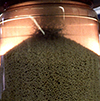München / May 30, 2016 - June 03, 2016
IFAT | Fair
World's Leading Trade Fair for Water, Sewage, Waste and Raw Materials Management
Hall A5, booth 217/316
World's Leading Trade Fair for Water, Sewage, Waste and Raw Materials Management
Hall A5, booth 217/316
IFAT is the World's Leading Trade Fair for Water, Sewage, Waste and Raw Materials Management – a place where visitors can find strategies and solutions for using resources in intelligent cycles in a manner that ensures their long-term preservation. This year again, Fraunhofer IGB is presenting R&D solutions and prototypes for water treatment and nutrient recycling.
Increasing costs for the purification and disposal of wastewater, and a growing awareness of the environment are resulting in using process waters several times, whenever possible, removing impurities selectively, and recycling of valuable components in the wastewater. Fraunhofer IGB has at its disposal numerous technologies for treating a wide range of chemically and biologically polluted process wastewaters from various branches of industry.
We look forward to your visit at the Fraunhofer Water Alliance booth in Hall A5, booth 217/316, where we present our topics summarized below. Also, we will be happy to arrange an appointment with one of our experts at the exhibition in advance. Please do not hesitate to get in touch with us.
Advanced oxidation and electrochemical processes for water treatment
 Fraunhofer IGB offers a variety of advanced oxidation processes and the respective mobile plants for treatment of water polluted with organics, which are not degraded in sewage plants. In the case of our new technologies such as electrolytic, photolytic and plasma-technological AOP processes, the reactive species are generated directly by the process itself, so that there is no need for the use of auxiliaries (gases, liquids) and for possible waste disposal. The electrolytic generation of hydrogen peroxide for water treatment in a one-stage oxidative-adsorptive process was demonstrated with landfill leachate.
Fraunhofer IGB offers a variety of advanced oxidation processes and the respective mobile plants for treatment of water polluted with organics, which are not degraded in sewage plants. In the case of our new technologies such as electrolytic, photolytic and plasma-technological AOP processes, the reactive species are generated directly by the process itself, so that there is no need for the use of auxiliaries (gases, liquids) and for possible waste disposal. The electrolytic generation of hydrogen peroxide for water treatment in a one-stage oxidative-adsorptive process was demonstrated with landfill leachate.
Electrochemical water treatment – desalination
A process for the separation of ions from an aqueous solution is capacitive deionization. The ions to be separated move according to their charge to the anode or cathode and charge these like a plate capacitor. Unlike other processes such as electrodialysis, however, no charge transfer takes place among the ions or with the electrodes, which is why this technology requires only low voltages of around 1.6 V. The energy consumption is therefore low. Once the charging capacity of the electrode is reached (if a capacitor is completely charged), the concentrate is released by polarity reversal and discharged as a concentrated electrolyte.
Biological water treatment
 Fraunhofer IGB has developed various bioreactors for wastewater treatment, for example anaerobic and aerobic loop reactors (gaslift / airlift reactors), membrane bioreactors or a fixed-bed circulation reactor in which the particle bed is periodically recirculated. Fixed-bed reactors are used in anaerobic technology to retain and thus enrich the active biomass that can become immobilized on and between the particles. On the Fraunhofer IGB fixed-bed circulation reactor the fixed bed is partially recirculated at certain times, thus permitting trouble-free operation on a sustained basis.
Fraunhofer IGB has developed various bioreactors for wastewater treatment, for example anaerobic and aerobic loop reactors (gaslift / airlift reactors), membrane bioreactors or a fixed-bed circulation reactor in which the particle bed is periodically recirculated. Fixed-bed reactors are used in anaerobic technology to retain and thus enrich the active biomass that can become immobilized on and between the particles. On the Fraunhofer IGB fixed-bed circulation reactor the fixed bed is partially recirculated at certain times, thus permitting trouble-free operation on a sustained basis.
Nutrient recovery and recycling
 While the demand for food and biomass has risen worldwide, mineral reserves such as phosphate ores are becoming scarce. Fraunhofer IGB is developing technologies to recover nutrients from wastewater and organic waste such as sewage sludge, manure or food industry waste. In these processes, nutrients are precipitated or pelletized in such a way that they can be used directly as agricultural fertilizer.
While the demand for food and biomass has risen worldwide, mineral reserves such as phosphate ores are becoming scarce. Fraunhofer IGB is developing technologies to recover nutrients from wastewater and organic waste such as sewage sludge, manure or food industry waste. In these processes, nutrients are precipitated or pelletized in such a way that they can be used directly as agricultural fertilizer.
ePhos® – electrochemical recycling of phosphorus from wastewater
In the ePhos® process developed at Fraunhofer IGB, ammonium and phosphate are precipitated from wastewater as magnesium-ammonium-phosphate (struvite) through a purely electrochemical approach using a sacrificial magnesium electrode. The recovered product (struvite) can be used directly in agriculture as a high-quality fertilizer as it releases the nutrients slowly.